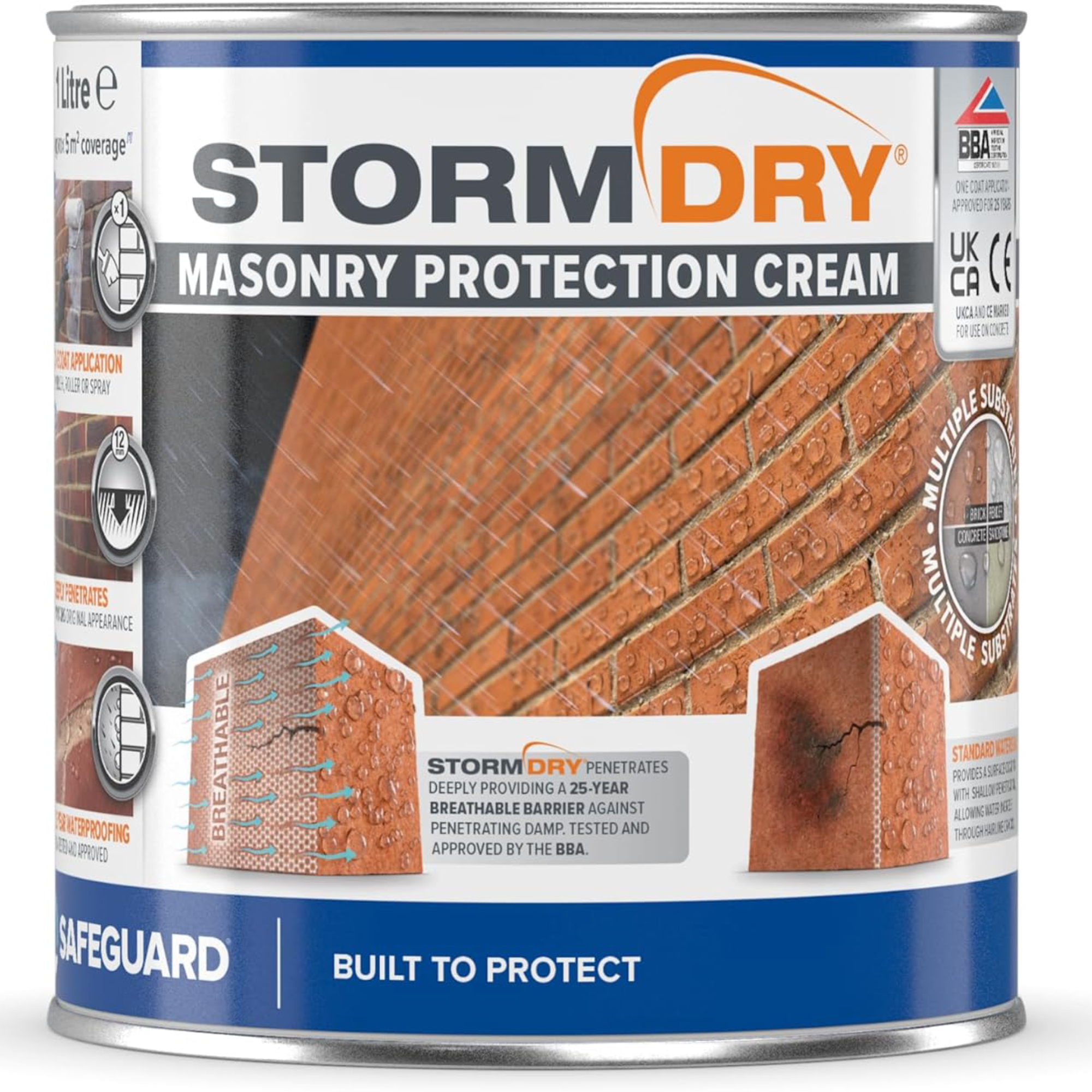Wondering why mould keeps appearing on your outside walls? Check out these expert tips on how to stop it and identify serious issues
If mould is appearing on your outside walls, you need to find out what it is, why it's happening and how to get rid of it

Mould on outside walls isn’t always what you think. It's typically different from the mould you’ll find in the home, but it's still unsightly, unwanted, and a sign that you have an issue that needs to be dealt with.
The right mould removal techniques will help get rid of this ugly, unwanted growth. But it might not be mould at all, as Dave Bendon, director of D Bendon Construction Ltd, shares. "The good news is, black, green, blue and even red patches on the outside of your house are often algae rather than mould.”
But, whatever it is, you’ll still want to say goodbye to it. This guide reveals the common causes, quick fixes, how to get rid of it, what you need to do to prevent it from coming back, and how to get your walls looking like new again.

Dave Bendon has over 30 years experience in construction, working on a variety of commercial and residential projects, including listed buildings and older properties that have been subject to damp and water ingress.
Common causes of mould on outside walls
Even if you feel you know everything about removing mould from walls and you've become an expert on the types of mould that exist, how you tackle the issue on the outside of your home will be different to the methods you use inside.
Most importantly, whereas the cause of mould in a house is often due to a build up of condensation, this is not a factor when it comes to external walls. Instead, there are a number of different reasons for the build up of mould-like damage and getting to the root of the problem is essential.
"Mould build up on external walls could be from a number of factors, such as a leak inside the property or poor condition of the exterior walls allowing moisture to permeate," says Checkatrade approved member, Edward Jonkler from Remora Restorations.
"It’s also often down to a lack of maintenance with guttering. Once bricks or exterior materials are saturated they become a potential environment for mould growth to occur. Rising damp is another source of moisture in external walls."
Bring your dream home to life with expert advice, how to guides and design inspiration. Sign up for our newsletter and get two free tickets to a Homebuilding & Renovating Show near you.
Tyr these exterior paints to refresh walls

A high-quality exterior paint with a creamy, smooth, easy-to-apply finish. Ideal for rendering, roughcast, pebbledash, concrete, building blocks, facing bricks and masonry painted surfaces.

A smooth masonry paint available in over 15 different colours. Rainproof in 30 minutes, it has anti-fade technology for longer-lasting colour, protection from mould and algae.

A premium water-based, solvent-free and non-toxic exterior paint that is available in over 100 different shades. A hard-wearing formula offers a waterproof, UV-resistant finish for long-lasting colour.

Edward Jonkler is a Property Care Association Qualified Technician, and a British Damage Management Association Technician, focusing on damp and mould issues in homes.
Step-by-step advice for getting rid of mould on outside walls
1. Find the cause of the mould
When it comes to knowing how to stop mould on outside walls, all the experts agree that if you can't find an obvious cause to fix the problem yourself, the most important first step is to call in the professionals.
“My advice for mould and damp issues is to seek a specialist to work out what the root cause of the issue is," says Andy Simms, construction expert at Mybuilder.com.
"Once you've discovered the cause, get it fixed as soon as possible. There's zero point treating the effects of mould without fixing the problem causing it.
“General builders are great for fixing guttering, repairing brickwork or roofing should a leak be your obvious issue. However, you might need a damp specialist to help you fully understand the root of your problem if it is not easily noticeable. They can tell you whether it’s rising damp, condensation, or a bigger issue such as penetrative damp."
Contact a qualified damp expert using a service such as Mybuilder.com who have a handy guide for hiring a damp proof specialist or seek advice from a professional through the Checkatrade website.

With almost a decade of experience on the front line in construction as a multi-trader, Andy Simms is well versed in many of the damp issues faced by residential home-owners.
2. Clear the area of any overgrown greenery
Buildings need to breathe which is why home ventilation is so important. And while we are often aware of the importance of letting air flow and move around the home, it's also essential to expose your external walls to air and sunlight. The biggest culprit for preventing this can be overgrown trees, bushes and plants.
Sunlight prohibits mould growth and constantly wet greenery pressing against your home will pave the way for penetrating damp to become an issue. Knowing how to stop mould on outside walls therefore means keeping on top of your tree growth and if maintenance is an issue, consider low maintenance garden ideas instead.

3. Clean the affected areas regularly
Once any problems have been fixed, next on the agenda is removing any build up of salts, algae, mould and dirt in order to allow the walls to breathe more effectively.
"Using a fungicidal chemical designed for exterior walls such as Sika Mould Buster would work best," says Edward Jonkler.
Sika Mould Buster from Amazon is also suitable for patios and driveways and has the added bonus of being biodegradeable.
Don't forget to clean in shaded areas such as underneath window sills and eaves, and for extra elbow grease consider using a stiff brush and then rinse with a hose or sponge off with water. And while it may be tempting to reach for chlorine-based bleach, remember this can run-off the walls and end up killing your plants and grass.

If the area you need to tackle is much larger, then other options include using one of the best pressure washers or steam cleaning.
"Pressure washing will achieve a great clean," says Dave Bendon, "but it's important to check it's suitable for your external wall finish before you start. While it may work well on bricks, it can for example cause damage to stone or render.
"You'll also need to be prepared to clean all the walls with it once you start," adds Dave, "as otherwise you'll end up with a patchy finish."
Steam cleaning, which has a much gentler approach, may be more suitable if you are dealing with a listed stone building.
If the main issue with your external walls is algae and dirt, the reality also is that even once your external walls are clean and you've repaired any problems, regardless of their construction methods, you will likely need to repeat the procedure every few years.

4. Waterproof coatings and facade creams
Once your walls are clean, you may want to consider adding a waterproof coating or facade cream depending on the external finish. Although they may not entirely inhibit mould or algae, they will provide a protective layer to prevent any future water ingress from permeating the walls.
Dave Bendon notes that while these can certainly be helpful, it's important to ensure these are also breathable so that moisture doesn't get trapped inside the walls.
Having once used a waterproof coating on an exterior wall that was exposed to driving wind and rain, my experience is that it had a limited success rate. However, it was a number of years ago and progression in product development makes it likely that the efficacy rate is now much better.
Re-painting with a masonry paint offering extra waterproof protection may also be an option, but ensure you check on the label or with a reputable tradesperson that it is suitable for your wall finish before applying any new coating, cream or paint product.
Try these clean and protect products

Breathable high-strength wall water seal for brick, stone, mortar, sandstone and granite offering a 25-year guarantee.

A multi-surface colourless weatherproofer for use on masonry, timber and stone to protect from penetrating damp.

An 1800W Electric pressure washer that is lightweight and easy to move, and efficient. It includes 4 x brass nozzles and 160Bar high pressure, ideal for cleaning masonry and wood.
FAQs
When is mould on outside walls a sign of something more serious?
Penetrating damp is caused by water ingress into the external walls of your house that eventually tracks its way inside when left unresolved.
It's the most common cause of the mould-like arrival of algae on your home and can be caused by a number of different issues:
- Cracks and gaps in your external wall finishes
- Problems with guttering and downpipes
- Leaks in the roof, eaves, fascias or soffits
- Overgrown trees, bushes and plants in consistent contact with walls
In general, all of the above can be remedied making it less likely for mould to appear inside your home in the long run.
But if the mould or damp problem only appears on the ground floor walls of your property, and is also close to the ground, you could have a rising damp issue that needs more than just a quick power wash.
Generally caused by a failure, or breach of your damp proof course (DPC), the most common signs on outside walls are "visible saturation of bricks, such as a darker area, or there could be visible salt deposits on the walls," says Edward Jonkler, something that's often referred to as salt banding.
It's also likely you'll see this rising tide mark on both the inside and outside walls of your home – particularly those internal walls that are outside facing.
If you think this could be a problem, it's essential to seek professional advice to repair your DPC course, or to assess if the issue is caused by external hard landscaping such as patios or driveways being laid above the level of your DPC.
Can rainfall cause mould on outside walls?
Rainfall causing algae or mould growth on outside walls is common and easily fixable.
"Algae thrives in damp conditions," says Dave Bendon. "The combination of the UK's relatively high rainfall and the fact that most external wall finishes – even renders which are classed as smooth – still have a textured surface that airborne algae will attach to.
"Or the walls are made from materials such as stone which lichen loves," he adds, "meaning you are likely to see a build up of discolouration every few years."
And while leaving dirt and algae won't necessarily lead to any bigger problems, it's always recommended that you deal with it to ensure it doesn't hide anything such as new cracks or external wall damage that can cause longer term problems such as permeating damp.
If you've tackled the problem outdoors and now need to repair the damage inside, follow our advice on how to remove mould from walls without damaging paint and try these budget-friendly products to get rid of mould around your home.

Sarah is Homebuilding & Renovating’s Assistant Editor and joined the team in 2024. An established homes and interiors writer, Sarah has renovated and extended a number of properties, including a listing building and renovation project that featured on Grand Designs. Although she said she would never buy a listed property again, she has recently purchased a Grade II listed apartment. As it had already been professionally renovated, she has instead set her sights on tackling some changes to improve the building’s energy efficiency, as well as adding some personal touches to the interior.
